
Indalecio Prieto Tuero was a Spanish politician, a minister and one of the leading figures of the Spanish Socialist Workers' Party (PSOE) in the years before and during the Second Spanish Republic.

Carlos Arias Navarro, 1st Marquess of Arias Navarro was the prime Minister of Spain during the final years of the Francoist dictatorship and the beginning of the Spanish transition to democracy.

Manuel Aznar Zubigaray was a diplomat under the Franco regime and one of the most important journalists of the 20th century in Spain.

Paseo de la Castellana, commonly known as La Castellana, is a major thoroughfare in Madrid, Spain. Cutting across the city from South to North, it has been described as the "true structuring axis" of the city.
Pablo Serrano Aguilar, was a Spanish abstract sculptor.

The symbols of Francoism were iconic references to identify the Francoist State in Spain between 1936 and 1975. They serve as visual illustrations for the ideology of Francoist Spain. Uniforms were designed for men and women that combined elements of the earlier Falangist and Carlist uniforms. The state developed new flags and escutcheons based on the traditional heraldry of the monarchy, but now associated with the state. The emblem of five arrows joined by a yoke was also adopted from earlier Spanish symbology, but after 1945 the arrows always pointed upward. This emblem appeared on buildings, plaques and uniforms.
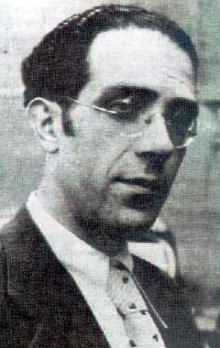
Jesús Hernández Tomás was a Spanish communist leader. During the Spanish Civil War (1936–1939) he was Minister of Education and Fine Arts, then Minister of Education and Health. After the war he went into exile in Oran, Moscow and then Mexico. He was expelled from the party in 1944 for disloyalty to the leadership, and purged from the official history of the party after writing a book in 1953 critical of the Stalinist role in the Civil War.
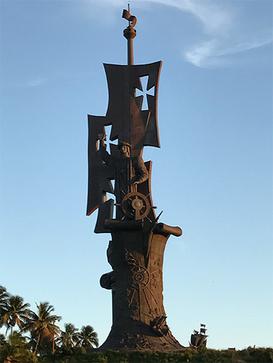
The Birth of the New World is a 360 foot (110 m) bronze sculpture located on the Atlantic coastline of Arecibo, Puerto Rico. When completed in 2016, it became the tallest sculpture in North America, surpassing Mexico's Guerrero Chimalli, and the fourth tallest worldwide, after the State of Unity in India, the Spring Temple Buddha in China, and the Laykyun Sekkya in Myanmar. After being imported to Puerto Rico, there were plans for it to be erected in Cataño. After being moved to Mayagüez and facing further delays, Birth of the New World was assembled at its current location.
Democratic Coalition was a Spanish electoral coalition formed in December 1978 to contest the general election the following year, after the approval of the Constitution.

Nuevos Ministerios is a government complex in central Madrid, Spain. The complex houses several government departments: Development, Labour, Social Security, and Ecological Transition. It is located in the block delimited by the Paseo de la Castellana, the Raimundo Fernández Villaverde street, Agustín de Betancourt street and the San Juan de la Cruz square.
José Luis Rodríguez Jiménez is a Spanish historian, considered an expert in the history of the right-wing extremism in Spain.

The third government of Felipe González was formed on 7 December 1989, following the latter's election as Prime Minister of Spain by the Congress of Deputies on 5 December and his swearing-in on 6 December, as a result of the Spanish Socialist Workers' Party (PSOE) emerging as the largest parliamentary force at the 1989 Spanish general election. It succeeded the second González government and was the Government of Spain from 7 December 1989 to 14 July 1993, a total of 1,315 days, or 3 years, 7 months and 7 days.

The equestrian statue of Francisco Franco was an instance of public art in Madrid, Spain. The statue, depicting dictator Francisco Franco riding a horse, was removed from its location in Nuevos Ministerios and subsequently stored in March 2005.

The Statue of Federico Martín Bahamontes is an instance of public art located in Toledo, Spain. It consists of a bronze statue representing Federico Martín Bahamontes, winner of the 1959 Tour de France and adoptive son of the city of Toledo.

The monument to Mendizábal was an instance of public art in Madrid, Spain. Located in the Plaza del Progreso, it consisted of a bronze statue of Juan Álvarez Mendizábal, architect of the Liberal reforms in Spain in the 1830s, and a stone pedestal. It was removed in 1939.
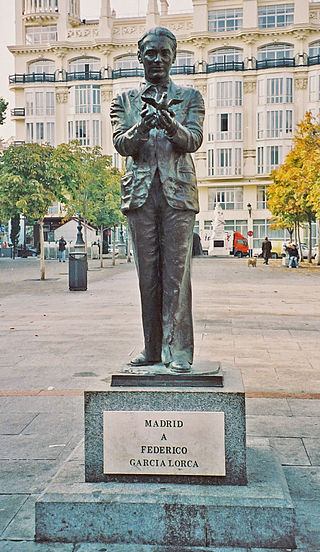
Federico García Lorca or the Monument to Federico García Lorca is an instance of public art in Madrid, Spain. Located at the Plaza de Santa Ana, in front of the Teatro Español, it consists of a bronze statue of the aforementioned poet and playwright.
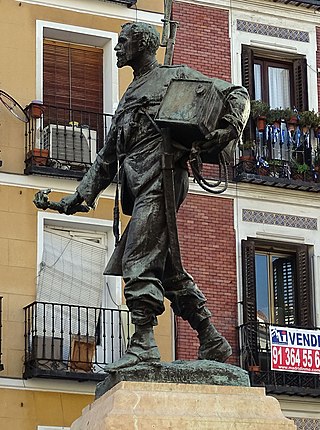
The Monument to Eloy Gonzalo is an instance of public art in Madrid, Spain. It is a monument dedicated to Eloy Gonzalo, the so-called Hero of Cascorro. Erected on the plaza de Cascorro, it consists of a bronze statue of the aforementioned Cuban War hero authored by Aniceto Marinas, put on a stone plinth.

The Monument to Hernán Cortés is an instance of public art dedicated to Hernán Cortés, conqueror of the Aztec Empire, erected in his native town of Medellín, Spain. It consists of a bronze rendition of Cortés designed by Eduardo Barrón on top of a stone pedestal.

The statue of Francisco Franco in the Spanish North African exclave of Melilla was the last remaining public one honouring Francisco Franco, the Nationalist leader during the Spanish Civil War and the dictator of Spain from 1939 until his death in 1975. Since the passing of the Law of Historical Memory, public symbols of him or exalting his regime, have been declared illegal. The statue survived until 2021 in public, on the technicality that it depicted Franco before the civil war and his dictatorship.
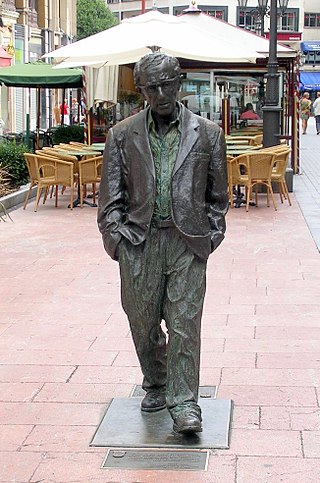
The Monument to Woody Allen is a life-size bronze sculpture of the American actor and director Woody Allen, situated in the Spanish city of Oviedo.

















